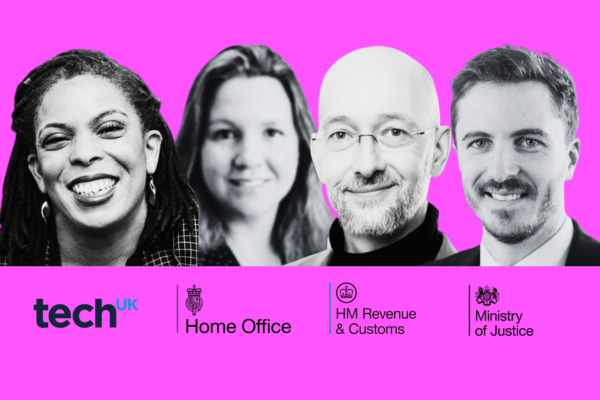The Art of Successful Government Transformation
What do you want your organisation to look like - and how do you get there? To answer this question we gathered Nic Granger, Executive Director of the North Sea Transition Authority (NSTA); Patrick Haston, Head of Cloud Transformation at the Cabinet Office; Sarah Ormerod, Programme Director of the Passports Transformation Programme at the Home Office and Kedar Nirhali, Solutions Consulting Manager at Boomi. The webinar, ‘The Art of Successful Transformation’ was sponsored by Boomi and mediated by our very own, David Wilde.
Where do we aim?
.jpg?width=250&height=250&name=sarah%20ormerod%20(1).jpg) Delivering a quality service is the ultimate end goal for successful transformation. For Sarah Ormerod, quality service is focused on the citizen experience. Sarah expressed the view that she would ‘like to see her organisation give every single customer an excellent service’. For the passport service, this means giving an experience that is digital, modern and fast.
Delivering a quality service is the ultimate end goal for successful transformation. For Sarah Ormerod, quality service is focused on the citizen experience. Sarah expressed the view that she would ‘like to see her organisation give every single customer an excellent service’. For the passport service, this means giving an experience that is digital, modern and fast.
For Nic at the NSTA, successful transformation is about enabling colleagues to make data-driven regulatory decisions supporting the energy transition and building an integrated energy basin going into the future.
Similarly, Patrick’s role in providing technical guidance for the shared services strategy is focused on supporting departments to come together in ‘clusters’ to share a single system for their back office HR and Finance processes.. The vision for this is to deliver a service that will improve the user experience for civil servants.
From a commercial perspective, Kedar who has worked directly with the UK public sector for Boomi reflected that they ‘try to align our roadmap to what we see as the major trends in government’. For Boomi, the trends that have configured this transformation have been a hybrid or multi-cloud model, the growth in API lead integration and ‘the elephant in the room’, generative AI.
Where do we stand?
Large strides have already been made to achieve digital transformation for the passport service. The next steps for the Passports Transformation Programme will be to further extend the quality experience to those that still require paper-based processing and human-based decisions such as those from high-risk countries and by bringing the premium service onto their new system.
 The NSTA was built on regulatory excellence, facilitating the right foundation for digital excellence. The Authority is 4 years through its 5-year digital and data strategy but ‘it won’t end at the end of 5 years’, Nic told us. As with many departments, the NSTA is still working to decouple data from legacy systems whilst still making it available for analysis. Progress has been made on this front, with the NSTA data ‘going out into industry’ whilst also consuming large amounts of industry data themselves. With supporting the energy transition being the strategic ambition of the NSTA’s transformation vision, Nic highlighted industry’s significant achievement in successfully reducing emissions for three years in a row. She said, ‘That couldn’t have been done without the data we collected and made available for industry. We have a dual focus of internal transformation to help people access data and digital tools, alongside working with industry to make sure they’re getting the most value out of the data’.
The NSTA was built on regulatory excellence, facilitating the right foundation for digital excellence. The Authority is 4 years through its 5-year digital and data strategy but ‘it won’t end at the end of 5 years’, Nic told us. As with many departments, the NSTA is still working to decouple data from legacy systems whilst still making it available for analysis. Progress has been made on this front, with the NSTA data ‘going out into industry’ whilst also consuming large amounts of industry data themselves. With supporting the energy transition being the strategic ambition of the NSTA’s transformation vision, Nic highlighted industry’s significant achievement in successfully reducing emissions for three years in a row. She said, ‘That couldn’t have been done without the data we collected and made available for industry. We have a dual focus of internal transformation to help people access data and digital tools, alongside working with industry to make sure they’re getting the most value out of the data’.
 Kedar’s current state assessment is that the public sector is at an important juncture in that he expects the data we use to only grow exponentially. This data ‘explosion’ will require consolidation and rationalisation and the government must soon face the fact that the data they are storing, such as in the Passports Transformation Programme’s 800 million passport records, will be to be stored at a sustainable pace.
Kedar’s current state assessment is that the public sector is at an important juncture in that he expects the data we use to only grow exponentially. This data ‘explosion’ will require consolidation and rationalisation and the government must soon face the fact that the data they are storing, such as in the Passports Transformation Programme’s 800 million passport records, will be to be stored at a sustainable pace.
Technical barriers, human barriers
The barriers towards successful transformation can be split into two categories: technical and human. As Kedar and Sarah share, poor interoperability stagnates processes and as data grows exponentially so will the silos and inability for different systems to exchange information with one another. Acknowledging the barrier, Sarah contributed that in passport transformation, ‘customers are still asked to send paper marriage and birth certificates to prove their identity, information which the Home Office already holds. Wouldn’t it be great if they didn’t have to send that paper and could just do so from their mobile phone?’
Data security and privacy are also major technical concerns. All governments across the board have regulations and carry vast amounts of sensitive data. Before transformation happens, they need to be confident that it’s secure and taken care of. Legacy systems also hold back agility and as Kedar puts it, it is ‘the last mile that needs to be taken care of’.
 On the human side, Patrick observes that whilst we may be able to put the technology in place to make processes easier, there are incentives in place to limit the savings potential of that technology and encourage civil servants to continue to ‘build empires’. As long as success is measured by how many staff one manages, it will be very difficult to translate the efficiencies technology enables into real savings, and headcount reductions will be ‘tough to push through’, he warned.
On the human side, Patrick observes that whilst we may be able to put the technology in place to make processes easier, there are incentives in place to limit the savings potential of that technology and encourage civil servants to continue to ‘build empires’. As long as success is measured by how many staff one manages, it will be very difficult to translate the efficiencies technology enables into real savings, and headcount reductions will be ‘tough to push through’, he warned.
Sarah added to this ‘empire building’ barrier by remarking that in addition to the perverse incentives of building unaffordably large teams and being unable to realise the cost-cutting potential of technology, large teams also slow down decision-making.
A further human barrier to successful transformation is skills. Nic highlights that in an NSTA industry survey they found that 60% had the digital skills for current technologies, dropping to a third for emerging technologies. You can update the technology, but if people don’t have the skills to use it, then you have your next barrier, she said.
People as the problem, people as the opportunity
Nic Granger emphasises that people are crucial to the success of any transformation, and that is why the process is an art and not a science. She states, ‘We know that data is important, but if you don’t have people's skills and culture in place, then we won’t get it right. We need to come at it less from the perspective of efficiency and more from the perspective of how transformation will be able to change everyday working life. We made people and skills the first pillar of our digital and data strategy because if you don’t get that right, you will waste a lot of effort’.
In agreement, Patrick elaborates on Nic’s point to state, ‘Technology is the easy bit. People challenges are much harder to fix but they’re much bigger opportunities as well”. As a driving force forward, he recommends in line with Nic, that a clear vision needs to be built to explain why we’re doing all of this. ‘By implementing 5 shared ERPs, you can join them up with common data standards and get answers in real-time. Though we might have to wait up to four weeks now to know exactly how many civil servants we have, through this new system we would be able to give Ministers data in real-time which could be truly transformational’.
On people, Kedar underscores the value of learning from one another. ‘We can build anything because we can learn anything. By learning from others, we need to take time to look back from other transformation programmes to avoid the common pitfalls which have stopped us from achieving things better, faster or cheaper’.
Budgets fueling the vision
One of the things the government is getting better at is making sure that when we’re doing a big transformation we’ve got an eye to a future and building services that can endure. This necessitates a long-term funding commitment which isn’t always the way government funding works. Setting out a clear business case by making sure with how the investment we make and into the future will make the organisation better, yields savings and improves citizen experience.
Nic Granger, Chief Financial Officer at NSTA, provides her insights on how to manage budgeting in times of transformation and dynamic business needs. She reflected that they have been able to learn by using pilots and breaking down projects into smaller chunks. Following on from the message that people are both the biggest barrier and opportunity to government transformation, investment can still happen without direct costs. This includes upgrading skills, and building on culture such as in the NSTA’s DigX Academy which gives ‘one member of the team the responsibility of signposting colleagues towards available resources, meaning people can go straight into our system and access the training. There’s no direct cost to use, but that can help us build our business cases and help people to understand the value beforehand.’
Rather than viewing money as an impediment to transformation, Patrick calls attention to the fact that in the shared services strategy, the cost of departments implementing the systems on their own inspired the approach of collaborating to share the cost, thus forming the basis of the Shared Services Strategy for Government. He goes on to say, ‘to deliver transformation across government is all about building relationships. You’ve got to talk to people, build up trust and listen to them. You can’t just dictate, it has to be in collaboration.’





